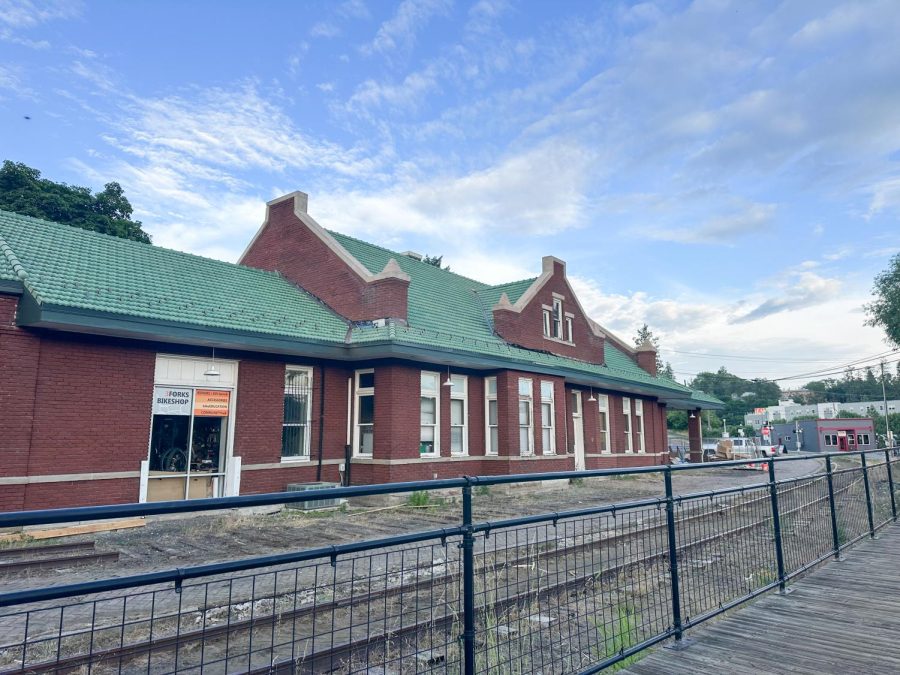Pullman Depot Heritage Center in first phase of restoration process
Depot to be as close to original building as possible, adding new photo-ops for students, alumni
The Pullman Depot Heritage Center as it stands today
June 15, 2023
The Pullman Depot Heritage Center is receiving grants from the Washington State Legislature as well as donations from other areas to help restore the building.
The depot was built in 1916, and just over a century later in 2018, it was bought by the Whitman County Historical Society, said Kathleen Ryan, Pullman Depot Heritage Center project manager. The Historical Society bought the building because it provides a good historical tie to Pullman.
The building is an old train depot, and the railroads are responsible for a lot of growth in the area, Ryan said.
When the trains were running, farmers were able to have grain shipped farther than before, she said. WSU, which was WSC at the time, was able to expand and rely on reliable transportation to get materials and students to Pullman before state highway systems existed.
“The Whitman County Historical Society saw this as a great opportunity to take this building and restore it and create a place to talk about the community since we don’t really have a history museum for the area in Pullman, or anywhere in Whitman County,” she said.
By restoring the building, some of the modern material will be removed to put in some aspects of the 1900s, she said.
Ryan said the depot has been working with Design West Architects to determine the best way to restore the building, which includes replacing bricks and stone and fixing up the roof.
“Our goal is to bring back the duty of the original brick, take off the two previous replacement roofs and put on the roof material that was originally placed on the building,” she said.
Linda Hackbarth, Pullman Depot Heritage Center chair, said the restoration process is currently in phase one of five, which is set to restore the bricks and the roof.
The second phase includes restoring the windows and doors, adding sockets on the building and restoring the restroom, Hackbarth said. The third phase will focus on the interior of the building.
Hackbarth said after phase three, she hopes to open up the facility while continuing to work on the restoration and adding a children’s area and more signage.
The depot has done campaigning and the community has gotten involved by donating toward the restoration process, she said. As of June 15, the project has raised just over a million dollars in donations. Donations are accepted online.
The project has also received two state heritage grants, which are funded by the state legislature but administered by the Washington State Historical Society.
The first grant of $258,000 will be available at the end of June and the second grant of $237,000 will be available at the end of July, she said.
Hackbarth said the people working on the project have spent a lot of time looking at old photos of the building to help create an idea of how to restore it to its original form.
They found some of the original roof tile, which led them to do more research because it was green, and all of the photos they found are in black and white which left them questioning what the original roof color really was, she said.
“We found a man who had grown up here in Pullman and had taken a photo of the depot when he was a kid and it had the green roof,” Hackbarth said. “That’s the first time I’ve seen a color photo of that tile.”
This led them to more research on the history of the depot, and while they want to make the building as close as possible to how it was originally built, there are some modern changes they will need to make, including making it compliant with the Americans with Disabilities Act, Hackbarth said.
They are also working on a project to add to the passenger car at the depot and extend the platform to represent what they are calling ‘Cougar Specials,’ because of the depot’s history with the railroads and trains, she said.
“We have old photos of the kids arriving at home and hanging out of the car and waving at everybody,” Hackbarth said. “We think that’ll be a great photo-op for students and alumni returning to campus.”
















